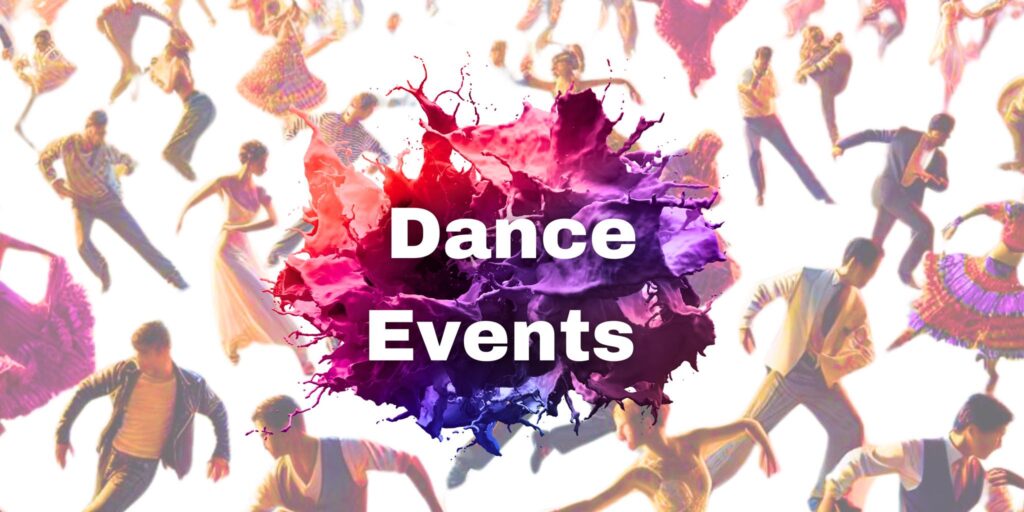There are many different types of dance events where people gather to socialize, perform, or compete. These events vary in style, formality, and purpose. Here’s a summary of some popular types of dance events (excluding classes):
1. Social Dances:
- Description: Informal gatherings where people dance socially, either in pairs or groups. They are usually held at clubs, bars, or community centers.
- Examples: Salsa nights, ballroom socials, swing dances, country dance nights, and tango milongas.
- Purpose: To socialize, practice dancing, and enjoy music in a relaxed atmosphere.
2. Dance Competitions:
- Description: Formal events where dancers compete in various categories based on skill, age, and style.
- Types:
- Ballroom Competitions: Couples compete in styles like waltz, tango, and cha-cha.
- Hip-Hop and Street Dance Battles: Dancers showcase freestyle or choreographed routines in one-on-one or crew battles.
- Latin Dance Competitions: Salsa, bachata, and kizomba competitions where dancers perform for judges.
- Purpose: To compete for titles, trophies, or recognition, often judged by a panel of experts.
3. Dance Parties (Dance Socials):
- Description: Casual dance events with open dance floors, often tied to a specific style like Latin, swing, or ballroom.
- Examples: Salsa parties, bachata socials, swing dance events.
- Purpose: For dancers to enjoy music, dance freely, and mingle with others. No competition or formal structure, just fun and social dancing.
4. Dance Showcases:
- Description: Performances by dancers or dance groups to display their skills, either at amateur or professional levels.
- Examples: Dance recitals, studio showcases, and themed dance nights.
- Purpose: To entertain an audience with choreographed routines or improvisational performances.
5. Dance Festivals:
- Description: Large, often multi-day events featuring performances, workshops, and social dancing.
- Types:
- Cultural Dance Festivals: Focused on traditional or regional dances (e.g., Flamenco, African, or Irish dance festivals).
- Music-Dance Festivals: Combines live music performances with dance (e.g., EDM festivals with freestyle dance areas, Latin or Caribbean music festivals).
- Purpose: To celebrate dance culture, provide entertainment, and create a community for dancers and enthusiasts.
6. Dance Balls:
- Description: Formal dance events, often themed or associated with a specific dance style (e.g., Viennese balls, masquerade balls).
- Examples: Gala balls, charity balls, or ballroom dance events.
- Purpose: Elegant, formal social dancing events, typically with formal attire and sometimes live orchestras.
7. Flash Mobs:
- Description: Spontaneous, large group dances performed in public spaces, often organized online or via social media.
- Examples: Large groups suddenly performing a choreographed dance in malls, parks, or streets.
- Purpose: Entertainment, surprise, or as part of social or marketing campaigns.
8. Dance Cruises:
- Description: Themed cruises centered around dance, often featuring workshops, social dancing, and performances on board.
- Types: Salsa cruises, ballroom cruises, and country dance cruises.
- Purpose: A vacation experience for dance enthusiasts, combining social dancing with travel.
9. Flashback/Themed Dance Nights:
- Description: Dance events centered around a specific era or theme, like ’80s night, ’90s night, or disco.
- Purpose: To relive or celebrate a particular music and dance style era, often with costumes and themed décor.
Summary:
Dance events come in various forms, from social dances where people casually dance, to competitions, festivals, and formal balls. These events cater to different dance styles and purposes, such as celebrating dance culture, entertaining audiences, socializing, or competing for titles. Each type of event has its unique atmosphere and draws a specific crowd of dancers.

